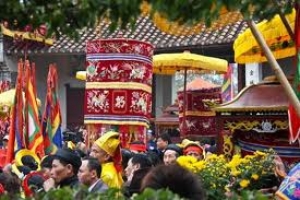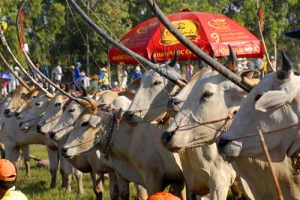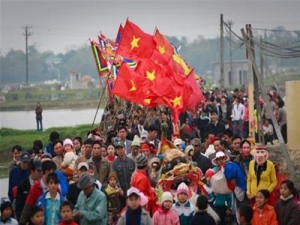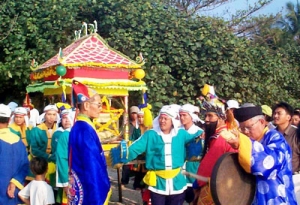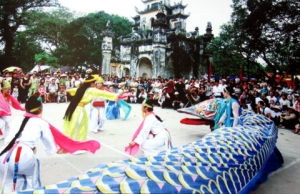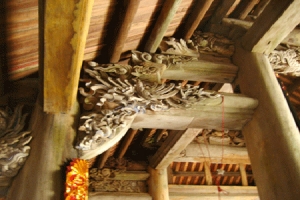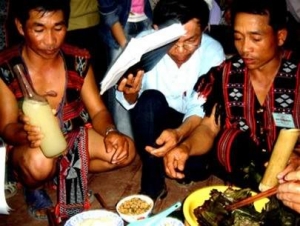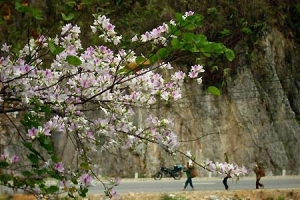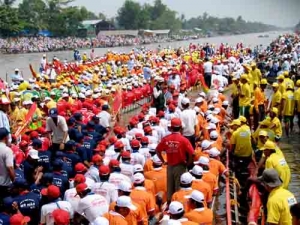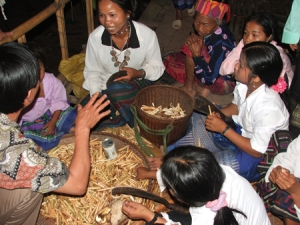
Asia Pacific Travel Team
An Duong Vuong Temple Festival - Legend and History
That's an unique festival in suburban area of Ha Noi. An Duong Vuong Temple is located in Co Loa village, Đong Anh district, Hanoi. It is on the way to Phuc Yên and about 17 km from the center of Hanoi. It associated with the story of An Duong Vuong, Au Lac and last State of Hung Vuong.
Located on this land is Ngu Trieu Di Quy communal house which is believed to be where the Thuc King held court. Am Ba Chua is the place where people worship the lovely daughter of the Thuc King, princess My Chau. We can now see a headless statue there, which is a vestige of the country lost by My Chau. She was so honest and credulous that she was trapped in a scheme by the enemy.
On the afternoon of the 5th day of the first lunar month, all of the eight communes (including Co Loa Commune and the establishing relations between seven communes) hold the incense offering ceremony at the communal house. On the 6th day of the first lunar month every year, people organize a festival which lasts for 10 days.
So, Vietnamese people have proverb: "Forget child, forget grandchildren, don't forget the 6th day of the first lunar month."
Thuong Temple is where the ceremony is performed with five-colour flags, a couple of pink horses and a couple of white horses on the two sides, the left and the right. Their harnesses are decorated with phoenix motifs and beautiful gold thread embroideries. In the center of the altar with an incense table is placed and loaded with the offerings, a glass box containing a pair of mandarin's boots and the King's weapons. Votive offerings include incense, flowers, truncated cone-shaped cakes made of sticky rice, fruits, steamed sticky rice, meat, giay cakes and popcorn.
Then, people of the 12 hamlets march around the Trong Thuy well and then go back to the Ngu Trieu communal house where only the palanquin of Co Loa is kept.
An Duong Vuong Temple Festival has many other fun activities. Evening in the village is burning fireworks, ca tru singing, singing classical opera. By day, he played all the instruments, chess. The old lady went home ceremony temple ceremony. Male and female adolescents have the game:swinging, wrestling, tug, rope climbing, archery it, people, rice blowing contest, cock fighting, type the original meter ...
On the final day of the festival, a grand farewell ceremony will be held at the temple. The rituals are the same as in the main festival day. After the rituals, the cult table of god will be returned to the sanctuary. Local people enjoy the god's favour and expect a year of prosperity and protection from the god.
Spectacular Bull Race Festivall in the Mekong Delta
Every year, thousands of locals and tourists gather in a paddy field in, Tinh Bien district An Giang Province to watch bull race. The event was organized during the Dolta Traditional Tet. It is a unique sport competition reflecting the traditional culture of the Khmer community in An Giang province in southwestern Vietnam.
This festival takes place as Khmer farmers start planting their autumn-winter crops. The origination of this festival in the local Khmer community’s centuries-old agriculture, when bulls would plough the fields during the rainy season. With time, the race became a traditional event to see who had the best bulls. Buddhist monks served as the organisers of the event and prepared the prizes for the winners.
The Khmer people in Bay Nui area love their bull as city dwellers love their new car! Normally, racing bulls work with their owner in the fields. Near the race, they are allowed to rest and practice. At this time, they enjoy a special care and good food such as young grass, sugarcane, bean sprout, corn, oil cake… When the competition day is coming, racing bulls are also fed with beer, hornet mixed with eggs, bathed clean, and sleep in the mosquito-net at night.
On the racing day, since it is still dark, every family has already waken up and pre-pare beautiful clothes and other necessary to bring along with them. Hamlets become boisterous. When dawn is coming, young, old, male, female people tingle to the bull race-course. The entire Bay Nui area is inundated by the festival atmosphere.

A fierce race.
A Bay Nui bull race features two pairs of bulls competing directly with each other to see which pair can drag a rake through the field the fastest. To win the victory, firstly we have to choose a pair of bulls having good stature and strong legs to easily control, the most important thing being that bull have to be faithful to owners.
The winning bull pairs are awarded. However, money doesn't matter. The first importance thing of the bull-race is bringing the pleasure to compatriot. The winner not only brings the glory to his family, his villages but also to his district.
If tourists in Vietnam travel have chance to visit An Giang province, don't miss to attend this festival and witness the fierce race.
The martial spirit in Lieu Doi wrestling festival
Unlike other festivals, wrestling is the main sport among other activities of the festival. Lieu Doi Village is located in Liem The Commune, Thanh Liem District, Ha Nam Province. This village festival occurs annually on the 5th day of the 10th lunar month. There remain a lot of legends of the origin of the festival as well as the legends of wrestling and team of wrestlers.

The villagers hold this wrestling festival to thank Thanh Ong (a man of the Doan family who fought against Chinese invaders and was also the ancestor of wrestling).
Lieu Doi’s legend has it that, a young man of Doan (Đoàn) family has the extraordinary power and the special ability of martial arts. He can defeat 5 competitors in the stage. One day, in Nuong Cui (Nương Cửi), a bright blue light ray frightened everybody but the Doan man. He came near it and realized that the light was from a sword placing in a red scarf. He kowtowed to the god, then held the sword, tied the red scarf around his waist and fenced in front of villagers.

The procession ceremony begins in the solemn atmosphere of the martial spirit. Offerings consist of some truncated cones of sticky rice, some bananas, and a pot of tea (substituting for wine). An old man holding a mirror walking backwards at the beginning of the procession starts the worshiping ceremony.
The next phase of the festival is the open fire ceremony. A great flame is set up, and an alderman hands over the sword and a reddish towel to the wrestlers. This ceremony is called "giving of the sword and the reddish clothes ceremony".

The last activity is the Thanh Dong ceremony and after several solemn ceremonies, the wrestling competition begins. First, two boys are elected by the villagers to wrestle for five rounds as a presentation (Five Round Custom). Next, the wrestlers from other localities participate in the round. It's a war flag dance, which is also called “superman going to the battlefield dance”. Atmosphere of the festival is exciting with drum, bell, gong...
Apart from the wrestling activity, the Lieu Doi Festival also has activities such as the performance of popular satirical verses, alternating folk songs, and the tasting of special dishes prepared by the local people for competition at the festival.
If tourists in Vietnam travel have chance attend this festival, you'll surely excited with its activities.
Nghinh Ong - the a jubilant festival in Vung Tau
The festival is jubilantly held with many and many exciting activities. Ba Ria – Vung Tau Province has many folk festivals: Trung Cuu festival, the Nghinh Ong festival, Thang Tam Temple festival, Dinh Co festival…Its cutture is the harmonious combination of all three North – Central – South. So, the festivals is particular.
Nghinh Ong festival is held in the fishing village in the province when the fishing season begins. The festival involves the rites of Ong worshipping, procession of Ong on sea by a big decorated boat with flag and flowers, bustling with drums and gongs. After the rituals are games such as boi singing, ba trao singing, martial performance Rituals performed in each place is different but there is always a procession of greeting Ong(the Big Fish) repertoire (whale) on the beach and then the “hat boi” organization.
Nghinh Ong festival in Vung Tau is the largest of all the festivals organised in the coastal provinces from Ninh Thuan to the south. The annual Nghinh Ong festival was held at the Ca Ong mausoleum (Hoang Hoa Tham Street, Vung Tau city) is the most solemn.
‘Ông’ is the respectful way in which the fishermen of southern Vietnam address whales and dolphins, which they believe to be guardian spirits. Whales in particular are believed to help fishing boats caught in storms to reach places of safety, and according to tradition fishermen arrange elaborate funerals for dead whales which have been washed ashore.
The legend tells whale worshiping customs is originated from Cham ethnic minority: “Because of Cha-aih-va named God want to come back quickly to his country after difficult magical practice that he answered back his trainer and self-wiled deformed to become the whale.

Nghinh Ong festival is held by the regional residents’ participation. Early morning, the festival start with people group included old men, village communes…going up a big boat which decored with flowers, flags, altar and ancestral tablet, the five notes group, gongs, drums, and lion dances group come to the defined location for offering incense, alcohol.
Then, group of boats come back wharf to welcome Ong to the temple, continuously the incense offering ceremony for our virtuous ancestors and virtuous posterities, reading funeral oration, honous, and then offering tea, flower and alcohol of pupils…

This festival also includes a lantern procession on board fishing boats, a basket boat competition.
Coming to the festival, travelers in Vietnam travel will have a chance to see many other cultural activities such as: martial arts, dragon dances, Hat Boi…with harmony rhythm of gong sound, drum-beat in full incense.
Snake dance and catching snake competition in Le Mat Festival
The Festival will make deep impression in tourists's mind, cause of its unique tradition. Le Mat village is located in Viet Hung commune, Gia Lam district, about 7km northeast from downtown Hanoi. It has been famous for a long-standing trade: snake catching and breeding, snake wine and tonics and snake dishes.
Old locals in the village said that snake catching and breeding in Le Mat has been practiced for almost 900 years. It is handed down from generation to generation among the villagers who consider it a valuable asset of their ancestors. Travelers in Vietnam Tourism to Le Mat nowadays, both domestic and foreign, want to know more about the traditional craft, on the other hand they enjoy special dishes and tonics made from snakes.
This village and its communal house are associated with a legend. While the daughter of King Ly Thai Tong (1072-1127) was on a pleasant boat cruise with her maids on the Thien Duc River (now Duong river), a big snake, pictured in popular imagination as a devil, overturned the boat by means of strong winds and large wave. The crew could do nothing to protect the unfortunate princess. But a young man from Le Mat village dived into the water, fought against the devil and, in the end, succeeded in killing it and saving the princess.
The King was deeply impressed by the young man’s courage and gave him a reward in gold and court titles. But the hero – a member of the Hoang family – graciously rejected the reward and, instead, requested the King to allow him and a number of poor people to reclaim land in the areas lying west of Thang Long, the Royal Capital, which was then surrounded by fallow land. As the King gave his assent, the young man set about rallying poor people from many parts of the country and led them in reclaiming land and establishing 13 prosperous and famous agricultural settlements in the neighbourhood of Thang Long.
Grateful posterity worshipped the young hero as the genius of their villages and on March 23 (lunar year) of each year the inhabitants of the former 13 agricultural settlements flocked in the Le Mat village to attend the festival.
The highlight of the festivities is the snake dance, an original performance held in the yard of the communal house; this dance is significant because the population of Le Mat is renowned for catching and breeding snakes.

The festival starts with a water procession. The villagers fetch water from the village pond, pour it into a big porcelain jar and put the jar on a palanquin and bring it to the Temple. The villagers also catch a big fish from the pond, put it on a tray and cover it with a red cloth, and bring it to the Temple as an offering to the Patron Saint.
After finishing all ceremonial prayers, the villagers gather at the temple yard to see the performance of the young man killing the snake and saving the princess. The snake is made of bamboo plates covered with cloth, 60m long and 60cm in diameter and looks ferocious. It is managed by a dozen young men. The well-dressed princess and her assistants dance beautifully. The man of the Hoang family, in red armour dress and holding a sharp lance, performs around the snake before killing it and saving the princess all to the sound of the drum beating and cheerful cries from the villagers. Visitors in Vietnam travel feel a so exciting, lively atmosphere.

The Festival is an opportunity for the children of the village to learn about and to be reminded of the history of the difficult establishment of their village, to share happiness. It's a good chance for the villagers to show respect to their ancestors and pride about the land of 1000-year Civilization.
Historical Festival in Quan Lan Village
Every year, Quan Lan villagers held a festival in June 18th (lunar calendar) to memorize the victory against Nguyen Mong army and chiến công of Tran Khanh Du. The festival’s location is Quan Lan communal house. Regatta is the most featured activity which is also the main one of the festival.
Travelling to Quan Lan (Van Don district, Quang Ninh provine), tourists not only have chances to enjoy the beautiful beach with majestic woods of Casuarinas but also are fascinated by the ancient beauty of Quan Lan village where there are many ancient communal houses and temple, court ministry clerk worshiping to adore the ancestors having contribution in the village establishment.
The village communal house was built in Hau Le empire (about XVII century) with the mast made by Man Lai wood which was harder than ironwood, bigger than the joining hug of two to three persons. On every buc con (bức cốn), lever, dau du (đầu dư), cau dau(câu đầu), sagged down gate…, there are images of dragon, male phoenix, flower, leaves that are sophisticatedly carved in different status. The communal house includes five rooms, two lean-tos, three ong muong (ống muống) compartments and one shrine lean-tos.
Different from other village communal houses, Quan Lan village communal house worships to adore King instead of Deity. The communal house worshiping to adore Ly Anh Tong king who establish Van Don trading port, a big foreign trading port on the coast of Mang river (now it’s Quan Lan area) 800 years ago (1149).

Every year, Quan Lan villagers held a festival in June 18th (lunar calendar) to memorize the victory against Nguyen Mong army and chiến công of Tran Khanh Du. The festival’s location is Quan Lan communal house. Regatta is the most featured activity which is also the main one of the festival.

The villagers have divided themselves in two team which are Dong Nam Van and Doai Bac Vo to practice since June 13rd. In 16th, they implement the deity picking ceremony: present the offering to take the ancestral tablet of Tran Khanh Du from the court ministry clerk to the communal house. In June 18th afternoon, all boats gather and do the performance symbolizing the three-time victory against Nguyen army then they sacrifice in the temple. After ceremony, the regatta starts.

The festival of Quan Lan village is a traditional festival which demonstrates the virtual art spirit of Vietnamese against the outside enemy to protect the sovereignty of country.
New Rice Festival of Upland People
The new rice celebration festival, also known as new rice Tet or Tet Ha Nguyen, is the biggest traditional festival of Vietnamese upland people. For people in ethnic groups, the festival is as important as Lunar New Year Tet to Kinh people.
The worshipping ceremony is took place annually, aiming to celebrate productive crops and to thank gods for helping villagers get those. Depending on each ethnic group, organizations, the festival will be held differently but commonly, there are offerings giving ritual, new rice eating ritual…
About the groups following Mon – Khmer language system (South Asia), the chief of village hosts to hold the new rice festival for the whole community. The festival usually happens when the very first rice packages are cut, about November or earlier December. It can last two or three days depending on estimated productive level of gathering crops. The festival location is Rong house, or the house of the chief.
The live offerings in the festival can be pig, cow and especially buffalo, for the Mon – Khmer language system groups if they get productive crops (at least a hundred packages of rice gathered). It is one of big communal festivals of every ethnic group in a year because comfort is seen clearly. In this festival, people usually invite their neighbor villages, cousins, or married sons or daughters living in other villages to come to join, communicate and create close relationships.
The M’nong people organize new rice festival in the earlier August when the rice starts to be ripe. Following the custom, they choose dinner time to hold festival. They use fresh leaves of banana tree to line the basket, put steamed rice and chicken into it and take a bowl of rice which has a beeswax light pitching onto to worship. All productive devices of the family are put on a basket; the meaning of this action is to welcome to return those devices before people can eat new rice. After worshipping, the host presents the meal and invites neighbors to have. Only one member of each neighbor family come to join the meal, there are gifts for others.
After the meal, the host invites neighbors to drink wine. Before drinking, the host takes some wine mixed with chicken blood, spreads this mixture on rice storage, altar, rocky cooker to return gods for supporting the family during the year.
Ban Flower Festival of the Thai
Every year, in the second lunar month, the weather starts to be shiny and warm after spring rains; ban flowers bloom white all over South West mountainous region, promising over-productive crops on fields and gardens. Ban flower festival opens when rice grows under spring rains, being lightly green on wet rice fields.
Ban flower festival (also known as Sen ban or Sen muong festival) is hold to pray for rain, happiness for villages of the Thai ethnic group. In the Thai’s concept, ban flower symbolizes not only love but also piousness, thankfulness.
From the early morning of the festival day, the sounds of drums, gongs clang wide open the mountainous region. The kitchens of house on stilts show the red flickering fire: people steam sticky rice, boil chicken, slice bamboo shoot; some families operate pigs for the banquet. There are many big and small jars of pipe wine (rượu cần) carried out for welcome guests. Girls and boys wearing beautiful clothes call each other to come to the forests where there are many ban flowers blooming. They select the most beautiful flower branches to give to their lovers and parents.

While Sen ban festival (organized once every two years) is only taken place in the scope of village, aiming to “pray for God’s support” and to worship for “washing leaves, driving God of insects away”, where there are few games, Sen muong festival (appearing once every three years) is hold in a large scope, attracting many talent people all over the village to join.

Sen muong festival lasts three days. The ceremony part is jubilant, sacred, and sincerely reverent with greeting crowd and sky-land, natural forces worshipping rituals. The festival part covers the majority of total time with hoa mai (hỏa mai) gun shooting, longbow, con (còn) throwing, and cock fighting… contests. Especially, in the jubilant sounds of drums and gongs, the circle of people spreading dancing almost happens continuously, seem not to stop.

For girls and boys in the village, the last festival night is most joyful. In the charming scenery of mountainous region, the charm-exchange (giao duyên) singing contest and the sounds of pan-pipe (khèn), flute last until midnight. From the festival, many love stories are formed and many couples get married. Due to this, the last night is also the most memorable one.
Om-oc-boc Festival of Khmer people
One vibrant, bustling activity which can be lacked in Oc-om-boc festival is Ngo boat race. Ngo boat is 24m long, 1.2m wide; both its prow and helm are curve, decorated by Khmer patterns; there is an animal image drawn in the prow.
Following the traditional custom, in the full-moon day of the tenth lunar month every year, the Khmer hold the moon worshipping festival that people manually called Oc-om-boc. Traditionally, to memorize the contribution of the moon which is considered the God managing crops, the Khmer people use the new glutinous rice to make com dep (cốm dẹp), being the main offering to worship the moon.
Especially, come to Oc-om-boc festival, visitors have a chance to take part in folk cultural game, entertainment such as: Lam Thol dancing, Ro bam, Du ke singing, snail chess competition, etc…

Besides that, tourists can contemplate the special water lamp, wind lamp of Khmer people. Water lamp is boat-shaped, having the made-from-banana-bark bottom with other materials including bamboo bars and paper. The lamp is decorated by brilliant colors, several kinds of cake, incense, oil lamp, and candles then released onto the water flow, creating sparkling and charming colors.
Wind lamp is a kind of entertainment which is artistic and scientific. People make it very simple: just with several pieces of paper which is rounded by bamboo bars and zinc yarns, something put inside to be the ignition. When fire is burnt, the inner air disappears, creating a force pushing the wind lamp flying high into the sky. It falls down when the fire is off. In each wind lamp, there is a kapok tail attached to the zinc frame, forming the shape of animal or word which looks very spectacular after being fired and flies high.

One vibrant, bustling activity which can be lacked in Oc-om-boc festival is Ngo boat race. Ngo boat is 24m long, 1.2m wide; both its prow and helm are curve, decorated by Khmer patterns; there is an animal image drawn in the prow. Every Ngo boat is built due to the labor and financial contribution of local people. The boats are preserved in the temple, launched on the water just once a year in the festival so the launching ceremony is very elaborate and cost.
Before the festival, all people practice elaborately, firstly swim on the land, and then do it on the water. The person chosen to be the leader standing on prow must be a prestigious one in the village. The Ngo boat race festival attracts lots of people in and out of the province to join among the vibrant cheer sounds.
Breaking Drum Festival of the Ma Coong in Quang Binh
Lovers may be single guy - single girl or wife – husband; even ones from different marriages can date with each other according to the free love offered by Giang
Belongs to Bru – Van Kieu ethnic group, the Ma Coong is a small group living in Thuong Trach commune, Bo Trach district, Quang Binh province. The legend has that the love night of the Ma Coong is derived by Giang (God) who helped local people to kill the naughty monkey that harassed crops, creating poverty, and after that he granted Ma Coong people a night of free love to live in wildness without worrying about restrictions and rules.
In the 16th night of the first lunar month every year, Ma Coong people gather in the sacred land that is Ca Roong village. In the festival night, when the moon rises highest, the chieftain reads the prayers asking the Gods to support for peaceful life, productive crops… After finishing the ritual, the rice will be thrown out, wishing that new rice will come to make the baskets, the crops full.

The banquet of offerings to worship Giang must include tube-wine, chicken, fish, sticky rice, top of rattan tree, a part of doac tree trunk. Each village has a banquet and there must be totally 18 banquets. The offering banquets must be made by members in the families of villages’ chiefs. After several times worshipping, the chief speaks the command to start the breaking drum festival. The villagers and also guests flow close to the drum. Everyone try to get the drumstick.

The festival drum has been made since the morning, drum body is made from the trunk of convex woody tree, and the leather covering the drum surface is made from the skin of cow. The drum is covered by old rattan; old bamboo is used to pack the drum surface to make it stretched. The persons who beat the drum must be the strongest guys. The drum must be beaten to be broken before the morning so that the god will recognize sincerity of people and they will get productive crops in the next year.

As well as beaten the drum, the young guys shout: “Roa lu Giang oi!” (This means “How happiness it is!”). The faster the drum is broken, the sooner young people can take their lover to the forest for making love.

After the drum is broken, each couple quietly holds the hands of each other; find their private place to chat, make love. The location may be on the mountain, near the stream or wherever. Lovers may be single guy - single girl or wife – husband; even ones from different marriages can date with each other according to the free love offered by Giang. There is no jealousy, no obstacle; others passing through and seeing this will consider it manual issue. This happens similar to Khau Vai love market or Moc Chau love market.
When the fire is about to be off, the sun slowly rises on another side of the mountain, it’s time for the breaking drum festival of the Ma Coong to be ended.


